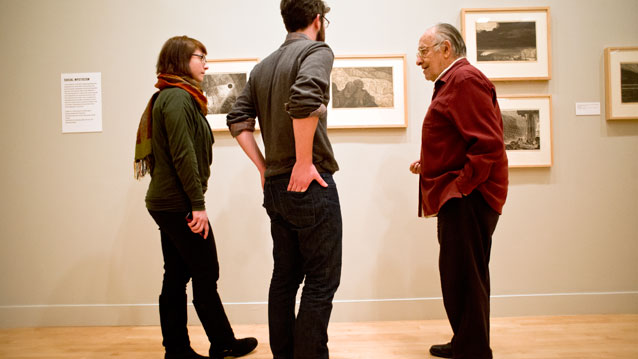EVANSTON, Ill. --- Carl Hoeckner Jr., the 92-year-old son of artist Carl Hoeckner, recently paid a visit to the Mary and Leigh Block Museum of Art to view “The Left Front,” a show of radical American art from 1929 to 1940 that includes 11 works by his father.
The widely acclaimed exhibition of left-leaning art also explores the political activism that inspired it. Touring the Block, Hoeckner Jr. reminisced about his boyhood days watching his father at work and reflected on the innovations he brought to lithography.
Hoeckner closely examined a lithograph titled “The Yes Machine,” the main subject of which he said was a composite of three affluent, unpleasant men that his father once knew. The haunting work of art created in 1934 depicts a grossly corpulent, wealthy man seated at a dining table surrounded by wraith-like, clearly hungry workingmen. The work clearly illustrates class disparities.
“He was a very principled man,” Hoeckner said of his father, whose political views are evident in his work.
Smiling repeatedly, he pointed to details in many of his father’s lithographs and said he remembered when his dad created them in the basement of their family home. For Northwestern and for Hoeckner Jr., himself, the visit was a moment in personal history set against the backdrop of his father’s artwork in the midst of the Block Museum’s historic show.
“Hoeckner was a visionary who developed his own unique artistic language through innovative printmaking,” said “The Left Front” co-curator Jill Bugajski. She, co-curator John Murphy, Lisa Corrin, the Block’s Ellen Philips Katz Director, and other museum staff accompanied Hoeckner Jr., as he explored the exhibition.
She said Hoeckner was an artist committed to progressive causes, though he expresses this subtly, through lyrical, darkly-woven narratives and meticulous drawing. Hoeckner was one of a number of Chicago artists the curators set out to highlight in conjunction with some of their better known New York contemporaries. “Together, these two geographies provide a fuller picture of the national story of American leftism in the visual art of the 1930s,” Bugajski said.
The Block Museum, which has strong holdings in works on paper, was a deep resource for the curators in developing the exhibition. In the midst of their research at the Block, they discovered several of Hoeckner’s prints.
Bugajski said that the more time she and Murphy studied Hoeckner’s prints, the more they grew to appreciate his symbolism and cataclysmic visions -- comprising a significant section of the exhibition on social mysticism.
Near the end of his Block tour, the artist’s son thanked the co-curators and Block staff for their thematic choice of “The Left Front” and the opportunity to look at his father’s work within the context of the other artists. “It reflects glory,” he said proudly. “My father would be pleased.”


